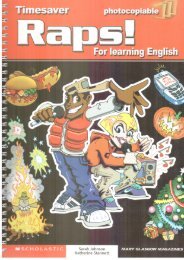English_Book_2-Teacher_300913
English_Book_2-Teacher_300913
English_Book_2-Teacher_300913
You also want an ePaper? Increase the reach of your titles
YUMPU automatically turns print PDFs into web optimized ePapers that Google loves.
TEACHER’S NOTESGrammar12 Some parts of speech (5 min.)A.• Have students look at the chart. Read the headingof each column aloud and have students repeat.• Elicit or explain the meaning of each part ofspeech: noun (name of a place, person, or thing),pronoun (word that can stand for a noun), adjective(word that describes a noun), verb (an actionword), preposition (word that shows direction/location or where a noun is in relation to anothernoun or nouns). Use L1 if helpful.• Explain that there are only three articles: a andan are indefinite articles and the is definite. Write aboy on the board. Point out that articles go beforenouns.• Point out Australia in the Nouns column. Elicit orexplain why it is capitalized. (It is a proper noun.)Elicit or explain the difference between a propernoun and a common noun. Give examples; forexample, Fred/boy, Postcards/book.B.• PAIRS. Depending on your students’ backgroundknowledge, you may want to have them workwith a partner to add two or more examplesin each column (except Articles). Check byeliciting answers and writing them on the board.Alternately, do this exercise as a class. Elicitexamples, write them on the board, and havestudents write them in their charts.B.• Read the instructions and have students workindividually to punctuate the items.• To check answers, call on two students to write theanswers on the board.Answer keyA: What’s your name?B: My name’s Lucia.A: That’s funny. My name’s Lucia, too.Communication14 Greetings (5 min.)• 10 Read the instructions aloud and play theaudio one or more times for students to repeat.Then elicit the answer for the first item. (Goodevening.)• Have students work individually to write in theresponses. Elicit the answers orally.Answer key1. Good evening. 2. Good morning.3. Good afernoon.Have students complete Workbook Exercises 1–14.13 Punctuation (5 min. or less)A.• Read the names of the punctuation marks aloudand have students repeat.• Elicit or explain when each punctuation is used:period (end of a declarative statement/sentence),question mark (end of a question), exclamation point(end of an exclamatory statement/sentence),comma (most commonly used to separate a seriesof words or to show a pause in a person’s thoughtsor speech). Use L1 if helpful.• Give an example for each and write it on theboard. Some examples:I am a teacher.Are you a student?Wow! She’s so beautiful!I can speak, read, and write in <strong>English</strong>.T5Postcards_splitB_TE1_FM.indd T52/27/07 10:23:19 AMvi-5_SB1




